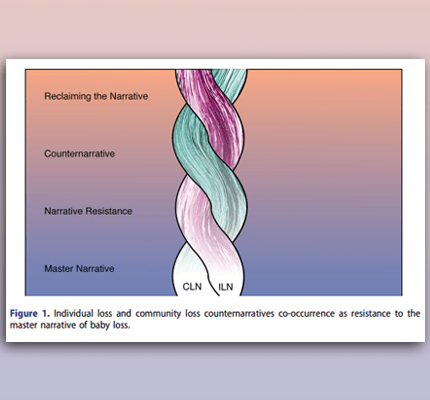
How Families Counter the “Master Narrative” of Baby Loss
According to the CDC, the U.S. infant mortality rate is 5.8 deaths per 1,000 live births. In addition, CDC data indicate that about 24,000 babies are stillborn in the United States each year, and tens of thousands of other babies are lost to miscarriage. Many families grieving the loss of their babies feel isolated by the experience. Now I Lay Me Down to Sleep (NILMDTS) offers a variety of services for families that have experienced the loss of a baby, including remembrance portraits, care packages, and a Remembrance Walk titled “Our Journey Together.” In a new article published in NCA’s Communication Monographs, Erin K. Willer, Emily Krebs, Nivea Castaneda, Kate Drazner Hoyt, Veronica A. Droser, Jessica A. Johnson, and Jeni Hunniecutt explore how the NILMDTS remembrance walk counters the master narrative around baby loss by creating an opportunity for families to remember their babies and connect with others who have experienced a similar loss.
...the “master narrative” around baby loss has largely been to treat it as a “non-event.” For much of the 20th century, parents and families felt pressure to move on quickly after losses, such as miscarriages, stillbirths, and infant deaths.
The authors argue that the “master narrative” around baby loss has largely been to treat it as a “non-event.” For much of the 20th century, parents and families felt pressure to move on quickly after losses, such as miscarriages, stillbirths, and infant deaths. Today, many grieving parents still report that they receive little support from others. The authors report that some women even feel that others “rejected women’s identity as mothers” after a stillbirth or infant death. According to the authors, family rituals, such as the NILMDTS Remembrance Walk, can “counter the master narrative of perinatal death for families.”
The authors conducted an ethnographic study during the 2014 and 2015 NILMDTS “Our Journey Together” Remembrance Walks in Littleton, Colorado. The authors attended the 2014 and 2015 Remembrance Walks, where they observed and interacted with attendees. After the Walks, they analyzed their notes to identify narratives. They identified two key counternarratives that helped dispel the master narrative: the communal loss narrative (CLN) and the individual loss narrative (ILN).
Communal Loss Narrative (CLN)
The CLN emphasized the shared experience of the participants. Cheryl Haggard, co-founder of NILMDTS, describes the purpose of the Remembrance Walk as “to let you know that you are not alone.” There were three subthemes that contributed to the CLN.
First, the CLN used “inclusive rhetoric,” language that emphasized the community of parents who had lost children. Speakers at the Walks emphasized “inclusive pronouns,” such as “we” and “our,” as in, “All of us here today share one of the greatest love stories in the world, and that is the love we have for our babies.” The authors argue that by using inclusive rhetoric, NILMDTS highlighted the shared experience that had brought families to the event.
The second CLN subtheme identified was honoring babies by name. During the Walks, balloons with babies’ names were released by participating families, and babies’ names were read aloud by a speaker. According to the authors, it took about 40 minutes to read the 350 names. The authors argue that the sight of the balloons emphasized the “visual scale” of losses that families had experienced. This portion of the event reflected a community brought together by shared experience.
The third CLN subtheme was emphasizing the community of support. NILMDTS offers care packages and photography services to families who have recently lost babies. The event was partially a fundraiser for these services. In addition, families contributed their time to the event by helping with setup. Thus, some families received support from NILMDTS, and others offered support to families through their involvement. The authors “interpreted these acts in line with the CLN as focusing on solidarity, anti-isolation, and joint sense-making.”
Individual Loss Narrative (ILN)
The ILN narrative highlighted the identities of the babies and their families. The authors identified two ILN subthemes: constructing family members’ identities and constructing babies’ identities.
Family members’ identities and relationships to the babies were recognized in a few ways. Although some attendees wore NILMDTS shirts, some attendees created unique shirts for their families that often emphasized their relationship to the baby, such as “Big Sister” or “Grandpa.” In this way, the relationship of individual family members to the babies was highlighted. Some families also added pictures, messages, or other items to their balloons to highlight the love individual family members felt for the baby.
Babies’ identities were also constructed by participants through the use of photographs and other artifacts. For example, some families posed with photos of their babies, which they also shared on social media. The authors argue that “this emphasis on identity building was central to countering the master narrative.” While the master narrative emphasized that the loss of a baby was a “non-event,” the ILN emphasized that babies and their family members had distinct identities.
Two Narratives Working Together
The authors conclude by discussing how the two counternarratives worked together. Whereas the CLN and ILN might appear to counter each other, they both worked together to dispel the master narrative that renders babies’ deaths invisible. The authors visualize the relationship of the narratives as “two strands of rope [intertwining]… to create an inseparable counternarrative.” For example, through the release of the balloons, individual babies were recognized, while at the same time the image of hundreds of balloons in the sky was a demonstration of community.






